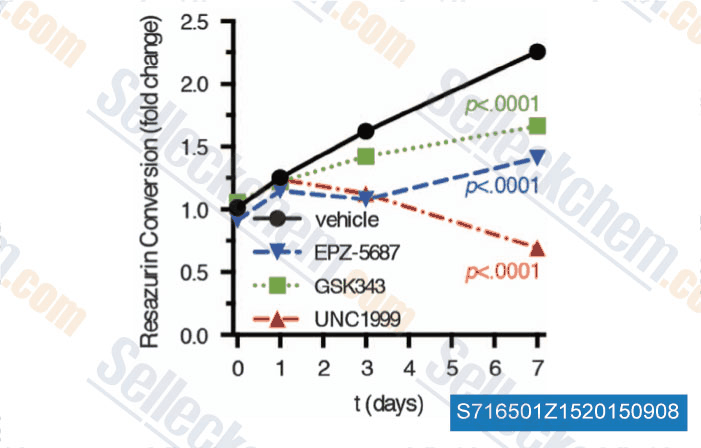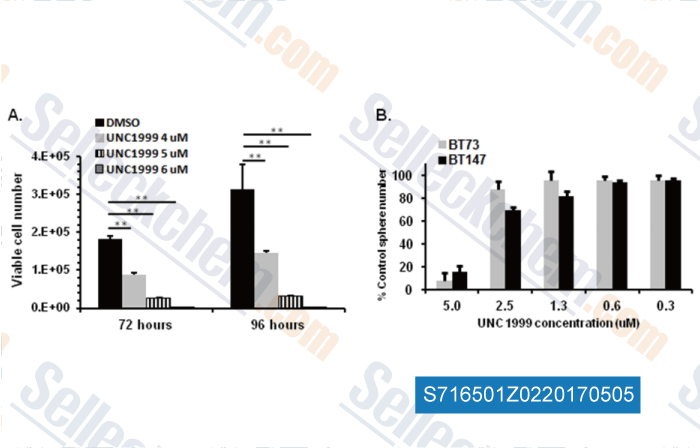|
Toll Free: (877) 796-6397 -- USA and Canada only -- |
Fax: +1-832-582-8590 Orders: +1-832-582-8158 |
Tech Support: +1-832-582-8158 Ext:3 Please provide your Order Number in the email. |
Technical Data
| Formula | C33H43N7O2 |
||||||||||||||
| Molecular Weight | 569.74 | CAS No. | 1431612-23-5 | ||||||||||||
| Solubility (25°C)* | In vitro | DMSO | 100 mg/mL (175.51 mM) | ||||||||||||
| Ethanol | 100 mg/mL (175.51 mM) | ||||||||||||||
| Water | Insoluble | ||||||||||||||
| In vivo (Add solvents to the product individually and in order) |
|
||||||||||||||
|
* <1 mg/ml means slightly soluble or insoluble. * Please note that Selleck tests the solubility of all compounds in-house, and the actual solubility may differ slightly from published values. This is normal and is due to slight batch-to-batch variations. * Room temperature shipping (Stability testing shows this product can be shipped without any cooling measures.) |
|||||||||||||||
Preparing Stock Solutions
Biological Activity
| Description | UNC1999 is a potent, orally bioavailable and selective inhibitor of EZH2 and EZH1 with IC50 of 2 nM and 45 nM in cell-free assays, respectively, showing >1000-fold selectivity over a broad range of epigenetic and non-epigenetic targets. This compound is a potent autophagy inducer. It specifically suppresses H3K27me3/2 and induces a range of anti-leukemia effects including anti-proliferation, differentiation, and apoptosis. | ||||
|---|---|---|---|---|---|
| Targets |
|
||||
| In vitro | UNC1999 is highly potent for both EZH2 Y641N and EZH2 Y641F mutants in vitro. This compound causes concentration-dependent reductions of H3K27me3 in MCF10A cells with IC50 of 124 nM , while shows low cellular toxicity. It displays potent, concentration-dependent inhibition of cell proliferation with EC50 of 633 nM in a DLBCL cell line harboring the EZH2Y641N mutant. In addition, biotinylated UNC1999 enriches EZH2 from HEK293T cell lysates, and thus may be used in chemoproteomics studies. [1] | ||||
| In vivo | Treatment of UNC1999 (150 and 50 mg/kg, i.p.) results in the plasma concentrations of this compound above its cellular IC50 over 24 hours in vivo. In addition, it is also orally bioavailable in mice, which makes chronic animal studies more practical and convenient. [1] | ||||
| Features | The first orally bioavailable inhibitor against wild-type and mutant EZH2 as well as EZH1. |
Protocol (from reference)
| Kinase Assay: |
|
|---|---|
| Cell Assay: |
|
| Animal Study: |
|
References
|
Customer Product Validation

-
Data from [ , , Oncogene, 2015, 10.1038/onc.2015.38 ]

-
Data from [ , , Oncotarget, 2016, 7(37):59360-59376 ]
Selleck's UNC1999 Has Been Cited by 36 Publications
| Inhibition of PRC2 enables self-renewal of blastoid-competent naive pluripotent stem cells from chimpanzee [ Cell Stem Cell, 2025, S1934-5909(25)00041-4] | PubMed: 40015279 |
| Chromatin modification abnormalities by CHD7 and KMT2C loss promote medulloblastoma progression [ Cell Rep, 2025, 44(5):115673] | PubMed: 40393452 |
| Epigenetic modifiers to treat retinal degenerative diseases [ bioRxiv, 2025, 2025.05.22.655558] | PubMed: 40501782 |
| LSD1 inhibition improves efficacy of adoptive T cell therapy by enhancing CD8+ T cell responsiveness [ Nat Commun, 2024, 15(1):7366] | PubMed: 39191730 |
| Ezh2 Delays Activation of Differentiation Genes During Normal Cerebellar Granule Neuron Development and in Medulloblastoma [ bioRxiv, 2024, 2024.11.21.624171] | PubMed: 39605517 |
| Hedgehog pathway orchestrates the interplay of histone modifications and tailors combination epigenetic therapies in breast cancer [ Acta Pharm Sin B, 2023, 13(6):2601-2612] | PubMed: 37425067 |
| Hedgehog pathway orchestrates the interplay of histone modifications and tailors combination epigenetic therapies in breast cancer [ Acta Pharm Sin B, 2023, 13(6):2601-2612] | PubMed: 37425067 |
| EZH2-H3K27me3-mediated silencing of mir-139-5p inhibits cellular senescence in hepatocellular carcinoma by activating TOP2A [ J Exp Clin Cancer Res, 2023, 42(1):320] | PubMed: 38008711 |
| BRD4770 functions as a novel ferroptosis inhibitor to protect against aortic dissection [ Pharmacol Res, 2022, 177:106122] | PubMed: 35149187 |
| Dual targeting of EZH1 and EZH2 for the treatment of malignant rhabdoid tumors [ Mol Ther Oncolytics, 2022, 27:14-25] | PubMed: 36212776 |
RETURN POLICY
Selleck Chemical’s Unconditional Return Policy ensures a smooth online shopping experience for our customers. If you are in any way unsatisfied with your purchase, you may return any item(s) within 7 days of receiving it. In the event of product quality issues, either protocol related or product related problems, you may return any item(s) within 365 days from the original purchase date. Please follow the instructions below when returning products.
SHIPPING AND STORAGE
Selleck products are transported at room temperature. If you receive the product at room temperature, please rest assured, the Selleck Quality Inspection Department has conducted experiments to verify that the normal temperature placement of one month will not affect the biological activity of powder products. After collecting, please store the product according to the requirements described in the datasheet. Most Selleck products are stable under the recommended conditions.
NOT FOR HUMAN, VETERINARY DIAGNOSTIC OR THERAPEUTIC USE.
